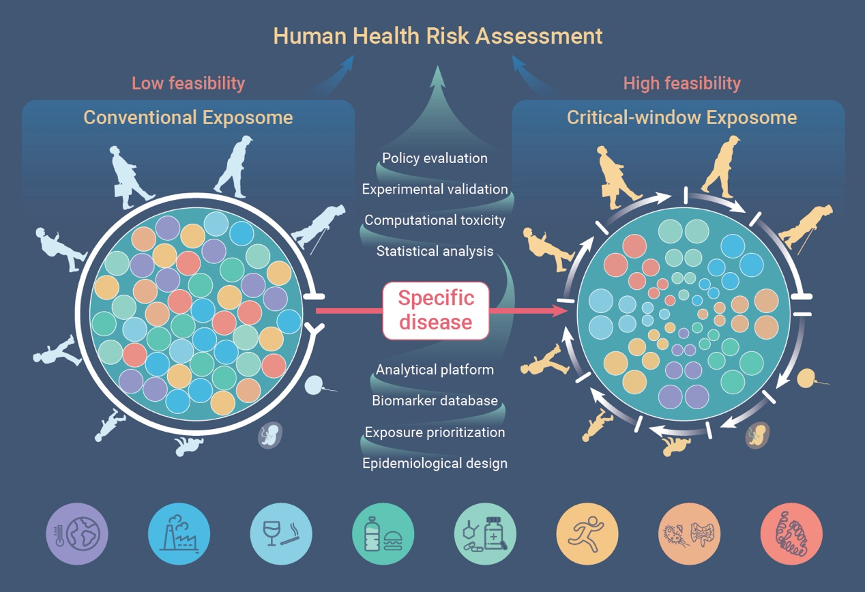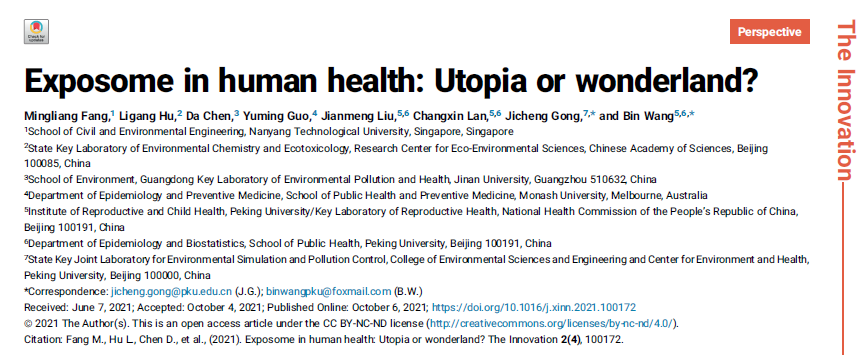
Academic progress
Prof. Bin Wang' team published a paper in The Innovation journal, providing a perspective on the future of exposomics research
Exposomics is an emerging frontier science dedicated to uncovering the causes of human diseases. Despite its potential, there are still numerous theoretical and practical challenges. To elucidate the relationship between the exposome and human health, Professor Bin Wang's team, in collaboration with scholars from both domestic and international institutions, has proposed an innovative approach to conducting exposomics research by identifying and focusing on critical time windows. This methodology holds significant scientific value in uncovering key environmental exposure factors that influence human diseases and in implementing effective disease prevention measures for susceptible populations.

Figure 1. From Traditional Exposomics Research to Critical Window Period Exposomics Research
Paper type: Perspective
First affiliated institution: Nanyang Technological University
First author: Mingliang Fang
Corresponding authors: Bin Wang (Peking University), Jicheng Gong (Peking University)
Journal: The Innovation, IF2022 = 33.1, CAS 1st Quartile
Article information: Fang M., Hu L., Chen D., Guo Y, Liu J, Lan C, Gong J*, Wang B*. Exposome in human health: Utopia or wonderland? The Innovation, 2021, 2: 100172. https://doi.org/10.1016/j.xinn.2021.100172
Main page: https://www.sciencedirect.com/science/article/pii/S2666675821000977

Health is an enduring topic for humanity. Researchers from various fields have made relentless efforts to uncover the causes of human diseases, aiming to improve the quality of life. Recent studies indicate that purely genetic factors can only account for a small portion (approximately 5-15%) of the causes of human diseases. In contrast, environmental factors and their interactions with genetic factors play a dominant role in the development of typical chronic diseases. Accurately characterizing the significant environmental exposure features throughout the human lifespan is crucial for uncovering the causes of human diseases.
To address the limitations of "genomics" in explaining the causes of human diseases, researchers proposed the concept of "exposomics" over a decade ago. The core idea is to comprehensively consider all exposure factors throughout the human lifecycle and reveal key environmental factors affecting human health through exposome-wide association studies. However, the progress in exposomics research has been relatively slow due to two main reasons: (1) Exposomics encompasses the entire human lifecycle from embryo formation to the end of life. Long-term monitoring of total environmental exposure throughout this period is extremely challenging, lacks technical support, is costly, and has low feasibility. (2) The environmental risk factors to which individuals are exposed throughout their lifecycle are exceptionally complex. Traditional exposure-effect association studies struggle to identify key risk factors for human diseases from the vast amount of information. Therefore, to effectively apply exposomics to solving real-world environmental health issues, the authors discuss the problems with the traditional concept of exposomics from three perspectives and propose possible solutions or directions for future efforts.
Perspective 1: What type of research is suitable for exposomics studies? Firstly, any health issue significantly influenced by environmental multi-factors and the interaction between the environment and genes, rather than solely determined by genetic factors, is suitable for exposomics research. Secondly, at this stage, exposomics research should focus on health issues in sensitive populations during critical exposure windows, such as adverse pregnancy outcomes, poor childhood development, and Alzheimer's disease. Conducting research on relatively short yet crucial time windows can enhance the effectiveness in addressing health problems by controlling costs related to time, money, and personnel, providing a new approach for exposomics design.
Perspective 2: Which environmental exposure factors should be prioritized, and how should exposure monitoring be conducted? The selection of exposure factors needs to be based on the type of disease; it is impossible to include all environmental factors. Priority should be given to factors that may have a causal relationship during disease formation, which can be divided into known and unknown factors. For known factors, previous research findings can be summarized, and risk can be ranked based on meta-analysis results, exposure scenarios, and professional knowledge, leading to "targeted" analysis. For unknown factors, high-resolution mass spectrometry and other "untargeted" methods can be used to identify as many key factors as possible. Combining these two approaches can greatly increase the efficiency of screening environmental risk factors. Additionally, optimizing sampling frequency according to the spatiotemporal variation characteristics of different environmental factors and incorporating individualized and localized exposure assessment techniques can improve the precision and accuracy of human exposure assessments while reducing costs.
Perspective 3: How to establish the causal relationship between the exposome and disease? Exposomics data is characterized by large volume, high dimensionality, and difficulty in distinguishing confounding and mediating effects. Therefore, it is crucial to overcome the limitations of traditional environmental exposure risk model analysis methods. Firstly, in research design, combining the strengths of observational and interventional studies, and choosing environmental epidemiology designs conducive to causal inference is essential. Secondly, aside from following traditional epidemiological analysis methods, causal analysis models suitable for exposomics research should be developed to control confounding factors and distinguish the contributions of mediating variables. Alongside constructing risk prediction models to support environmental health risk assessments, statistical models can be employed to screen important environmental exposure risk factors from vast amounts of data. Additionally, combining computational toxicology, experimental toxicology, and randomized controlled trials can further pinpoint the key factors of disease. Overall, focusing on specific health issues, screening potential environmental influence factors, building statistical analysis models, conducting toxicological simulations, and further intervention verification and policy assessment will form a robust human health risk assessment system based on the critical time window exposomics concept.
Summary and Outlook:
This research provides new perspectives on the future development directions of exposomics. By integrating knowledge from multiple disciplines to develop next-generation human health risk assessment technologies—including epidemiology, clinical medicine, chemistry, environmental science, socioeconomics, toxicology, and other disciplines—it is believed that exposomics research will certainly experience vigorous development. This will make significant contributions to the comprehensive understanding of disease etiology in humans.
Acknowledgments:
We thank the China Cohort Consortium (https://chinacohort.bjmu.edu.cn/) for their collaborative assistance. We also acknowledge the support from the National Natural Science Foundation of China and the key research projects of the Ministry of Science and Technology of China.
Author Biography:
First Author:
Mingliang Fang is an Assistant Professor in the School of Civil and Environmental Engineering at Nanyang Technological University (NTU), Singapore, and the Director of the Analytical Center at the Nanyang Environment & Water Research Institute (NEWRI). He primarily develops exposomics methods and utilizes omics technologies to investigate the toxicity and mechanisms of pollutants. His research outcomes have been published as first or corresponding author in leading journals such as Nature Chemical Biology, PNAS, Environmental Health Perspectives, Environmental Science & Technology, and Analytical Chemistry. Additionally, he has contributed as a co-author to over 70 publications in top-tier journals like Nature Methods, Cell Stem Cell, and JACS. Currently, he serves as the Associate Editor of the authoritative journal Environmental Pollution and is a member of the editorial boards of ES&T Water, ESPI (RSC), Environment International, Environmental Research, Chemosphere, and Exposome (Oxford)。
Corresponding authors:
Bin Wang, Associate Professor/Researcher with tenure at the Institute of Reproductive Health, School of Public Health, Peking University. His main research areas are environmental health, exposomics big data, and artificial intelligence. He employs multidisciplinary research methods to elucidate the impacts and mechanisms of environmental pollution exposure on reproductive health, and to construct health risk assessment models. To date, he has led three projects funded by the National Natural Science Foundation of China (General Program and Youth Fund), and played a key role in three National Key R&D Program projects. He has published 55 papers as the first or corresponding author in international authoritative journals such as Environmental Health Perspectives, Environmental Science & Technology, and The Innovation (H-index = 42, with over 6,500 citations). He serves as a thematic editor for the top journal in the field of environmental health, Environmental Science & Technology, and is involved as an editorial board member for several well-known domestic and international journals (The Innovation, Environment International, Environment & Health, Eco-Environmental Health, China CDC Weekly, and Journal of Environmental Hygiene). He has introduced the undergraduate course "Exposomics," the graduate course "Environmental Exposomics," and the international public health master's course "Environment & Health." He is the leader of the "Environment and Population Health" group of the China Cohort Consortium and the Deputy Secretary-General of the Environmental and Reproductive Health Special Committee of the Environmental Mutagen Society of China. He has received the second prize from the Beijing Preventive Medicine Association for Scientific and Technological Progress and the title of "Outstanding Individual in the National Scientific and Technological System for Fighting COVID-19."
Jicheng Gong, Researcher at the College of Environmental Sciences and Engineering, Peking University. His research focuses on studying the health effects and biological mechanisms of environmental pollutant exposure on humans through the development and measurement of biomarkers. He has published over 60 SCI papers in prominent international journals in the fields of medicine and environmental science, including The Lancet, Environmental Science & Technology, and Environment International. He has undertaken projects such as the "Second Comprehensive Scientific Expedition to the Qinghai-Tibet Plateau" and general projects funded by the National Natural Science Foundation of China. He has received the Young Scientist Award from the Chinese Society for Environmental Sciences. Currently, he serves as an editorial board member of the Journal of Thoracic Disease.
Contributed by | Professor Bin Wang's Team (Peking University)
Reviewed by | ExposomeX Team

